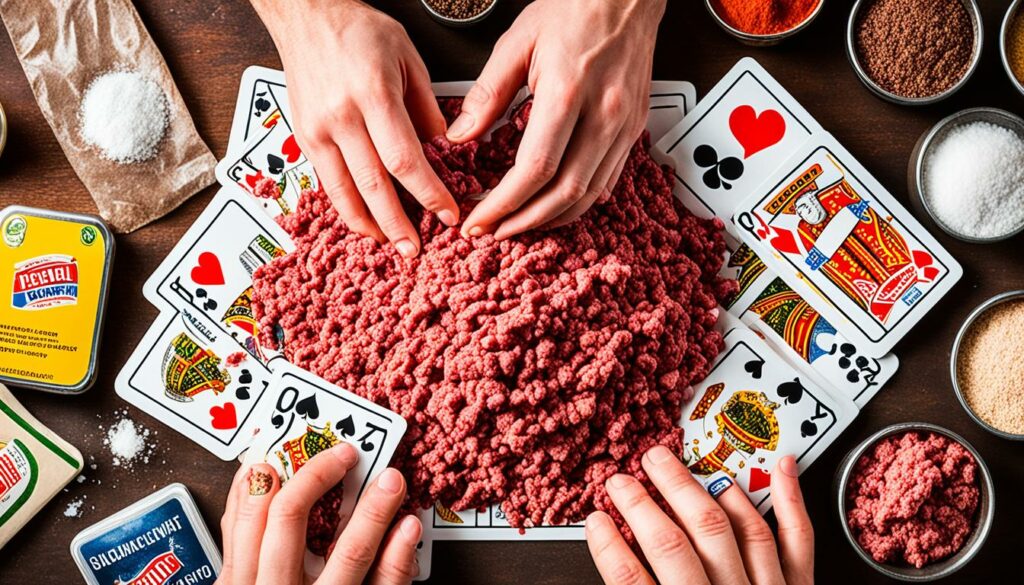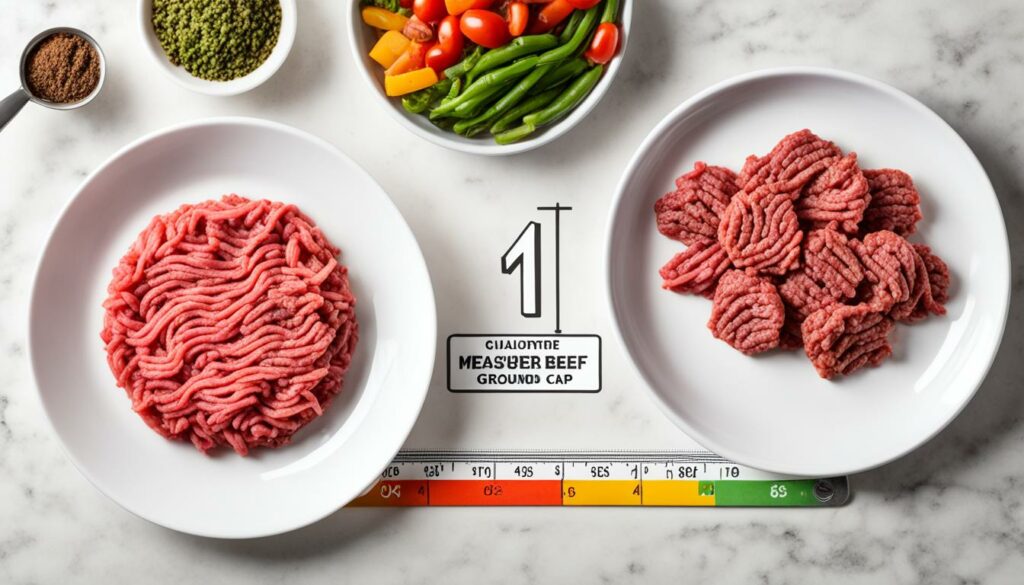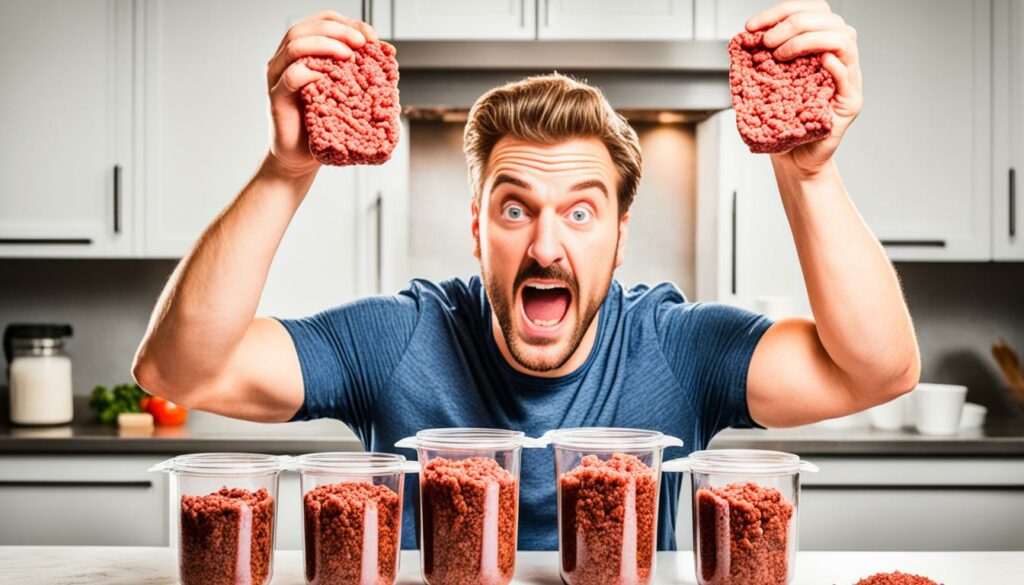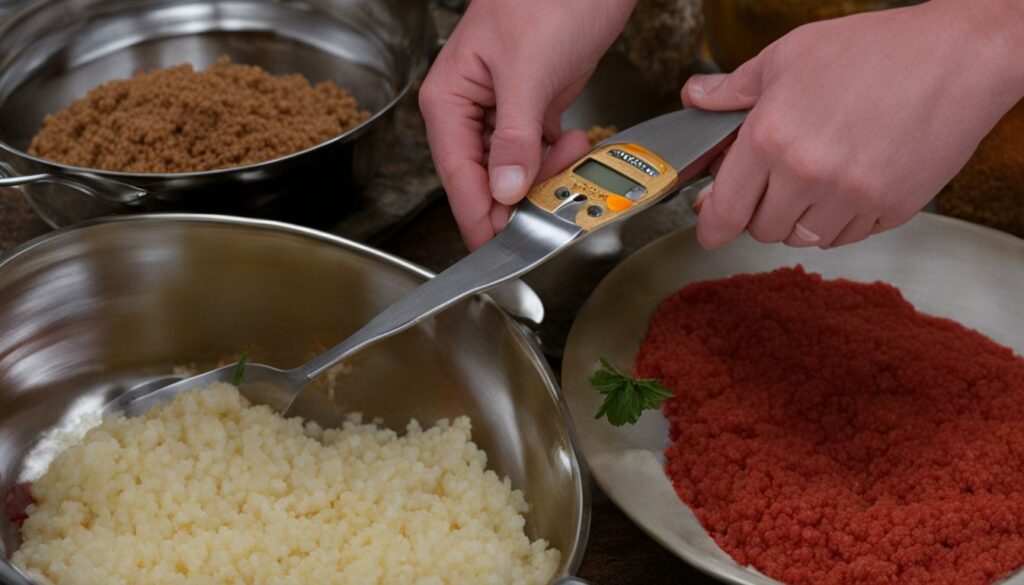Did you know that the average American consumes approximately 222 pounds of red meat per year? That’s a staggering amount of ground beef being used in kitchens across the country! But what if you don’t have a scale to measure out the perfect portion of ground beef for your recipes? Don’t worry, there are simple and effective methods to measure ground beef without a scale. Whether you’re trying to follow a specific recipe or portion out servings for a large gathering, these hacks will help you estimate the weight of ground beef accurately.
Key Takeaways:
- Even without a scale, you can accurately measure ground beef for your recipes using alternative methods.
- Using measuring cups and spoons can provide a convenient way to convert ounces to cups or tablespoons.
- Household objects like tennis balls, softballs, and decks of cards can serve as visual guides for estimation.
- Your hands can be used as a reference for portion sizes, with your palm and fist providing general measurements.
- Your dinner plate can also be used as a guide, helping you estimate the amount of ground beef needed.
Using Measuring Cups and Spoons
When it comes to portioning ground beef accurately, measuring cups and spoons are handy tools that can help you achieve the desired quantity for your recipes. Whether you’re converting ounces to cups or tablespoons, these simple kitchen utensils make the process effortless.
Here’s a quick guide on how to measure ground beef using measuring cups and spoons:
- Convert recipe instructions: If your recipe calls for ounces of ground beef, you can easily convert it to cups. Keep in mind that each cup contains eight ounces of ground beef, so you can use this ratio to estimate the quantity you need.
- Example conversion: Let’s say your recipe requires one pound of ground beef. Since a pound is equal to 16 ounces, you would use two cups of ground beef instead.
- Fluid ounce conversion: Additionally, if your recipe specifies ounces of ground beef, you can also convert it to tablespoons. One fluid ounce is equivalent to two tablespoons, so this conversion can come in handy.
Next time you’re ready to cook with ground beef, grab your measuring cups and spoons to ensure accurate portioning. By following these simple conversions, you can confidently recreate recipes without the need for a scale.
Benefits of using measuring cups and spoons:
“Measuring cups and spoons provide a convenient and reliable way to portion ground beef accurately, eliminating the guesswork in the kitchen.”
Using measuring cups and spoons not only helps you achieve the desired consistency in your dishes but also ensures that you’re using the right amount of ground beef for your nutrition needs. So, the next time you’re cooking with ground beef, reach for your measuring cups and spoons for precise and satisfying results.
Using Household Objects for Estimation

If you don’t have measuring cups or spoons available, you can use common household objects as a guide for estimating ground beef quantity. These everyday items can help you measure without the need for specialized tools.
- A tennis ball is about 1/2 cup of ground beef.
- A softball is approximately 2 cups of ground beef.
- A three-ounce steak is about the same size as a deck of cards.
- One ounce of cheese is approximately three dice in volume.
These household objects provide a tangible reference for estimating the amount of ground beef you need for a recipe. By utilizing items that you likely already have at home, you can confidently portion ground beef without relying on measuring tools.
Using common household objects for estimation can be a fun and practical way to measure ground beef without tools.
Estimating with Familiar Objects:
Applying everyday items like tennis balls, softballs, and decks of cards allows you to visualize and equate quantities easily. By associating specific volumes with familiar objects, you can quickly estimate the amount of ground beef for your desired dish.
Using Your Hands as a Reference
Your hands can be a useful tool for estimating the weight of ground beef. For meat and fish, your palm can hold about three ounces, which is the usual serving size for adults. When it comes to fresh produce, eight ounces of fruits or vegetables is roughly the size of a balled-up fist. For cheese, one serving size is about the size of your thumb, which is approximately one ounce. These hand measurements can give you a general idea of the quantity of ground beef you’re working with.
If you’re unsure about the weight of your ground beef, or if you don’t have a scale handy, using your hands can be a convenient and reliable way to estimate. This method allows you to portion the ground beef according to your recipe’s requirements without the need for any additional tools.
Estimating Portion Sizes with Your Hands:
- For ground beef, use your palm to approximate three ounces, which is the recommended serving size for meat and fish.
- If you’re looking to measure eight ounces of fruits or vegetables, envision a balled-up fist as a useful guide.
- To estimate an ounce of cheese, compare it to the size of your thumb.
By utilizing the size and capacity of your hands, you can confidently portion ground beef without the assistance of a scale. This method is particularly helpful when you’re in a hurry or cooking in a location where a scale may not be readily available.
Using Your Plate as a Guide

If you don’t have a scale on hand but still need to measure ground beef for your recipes, you can use a simple and visual method using your dinner plate as a guide.
When using your plate as a reference, keep in mind the following portion sizes:
- If your food takes up 1/4 of the plate, it’s approximately 1 to 1 1/2 cups or 8-12 ounces of ground beef.
- If your food fills up half the plate, it’s about 3 cups or approximately 1.5 pounds of ground beef.
This visual estimation method can help you get a general idea of the amount of ground beef you’re using in your recipes, allowing you to make adjustments according to your needs and preferences.
Remember, it’s always a good idea to double-check the measurements by using measuring cups and spoons or other alternative methods if you require more precise quantities.
To summarize:
Using your plate as a guide, if your food takes up 1/4 of the plate, it’s approximately 1 to 1 1/2 cups or 8-12 ounces of ground beef. If your food fills up half the plate, it’s about 3 cups or 1.5 pounds of ground beef.
Sources:
| Source | Link |
|---|---|
| USDA | https://www.usda.gov/ |
| Food Network | https://www.foodnetwork.com/ |
Other Options: Buying a Food Scale

If none of the previous methods suit your needs, you can always opt to buy a food scale. A basic food scale can be purchased for around $10 on platforms like Amazon. While there are more expensive options available, a budget-friendly scale can serve the purpose just as well. Having a scale in your kitchen can provide accurate measurements for various ingredients, including ground beef.
Investing in a food scale can be a worthwhile addition to your kitchen tools. Not only does it enable precise measurement of ground beef, but it also allows for consistent portions in your cooking. With a food scale, you can follow recipes precisely and confidently, knowing that your ingredients are measured accurately. Whether you’re portioning ground beef for burgers, meatballs, or chili, a food scale provides reliable results.
Food scales come in different styles and designs, with various features to suit different preferences. Some scales have digital displays for easy reading, while others have additional functions like a tare function to subtract the weight of a container. Consider your specific needs and budget when choosing a food scale for your kitchen.
Using a food scale not only helps you measure ground beef accurately, but it can also assist in portion control and maintaining a balanced diet. If you’re watching your calorie intake or following a specific dietary plan, a food scale can help you track your food portions and stay on track with your goals.
When using a food scale to measure ground beef, place a clean container or dish on the scale, then reset the scale to zero. Add the desired amount of ground beef to the container until you reach the desired weight. If your recipe calls for a specific weight of ground beef, a food scale provides the most precise measurement.
Remember, a food scale is a versatile tool that can be used for measuring other ingredients as well, such as flour, sugar, and spices. It adds accuracy and consistency to your cooking, ensuring that your recipes turn out just right every time. Consider adding a food scale to your kitchen arsenal for precise measurement and delicious results.
Conclusion
Measuring ground beef without a scale is possible using alternative methods and tools. Whether you don’t have a scale on hand or prefer to estimate, there are several reliable ways to ensure accurate portioning for your recipes.
By using measuring cups and spoons, you can convert measurements from ounces to cups and tablespoons, allowing for precise ingredient ratios. Alternatively, common household objects can serve as helpful guides for estimation. For example, a tennis ball is approximately 1/2 cup, and a softball is about 2 cups.
Your own hands can also be an invaluable resource for measuring ground beef. For instance, your palm can hold about three ounces of meat or fish, and your balled-up fist is approximately eight ounces of fruits or vegetables.
Another method is using your plate as a guide. By visualizing how much space your food takes on the plate, you can estimate the quantity of ground beef needed for your recipe.
If none of these options work for you, investing in a food scale can provide precise measurements for various ingredients, including ground beef. A simple food scale can be purchased for around $10.
Remember, it’s important to adapt these methods to your specific recipe and desired outcome, as they provide estimations rather than exact measurements. Use them as helpful guidelines to adjust portions according to your taste preferences and the requirements of your dish.
With these alternative methods and tools, measuring ground beef without a scale becomes more accessible and convenient. Whether you choose to rely on your hands, household objects, or invest in a food scale, you can confidently portion ground beef for delicious meals.
Tips and Tricks for Accurate Portioning
When it comes to measuring ground beef by hand, there are a few tips and tricks to ensure accurate portioning. By keeping these methods in mind, you can confidently estimate the amount of ground beef needed for your recipes.
One helpful guideline is to use your hand as a reference. A clenched fist is approximately eight ounces, which is the standard serving size for fruits and vegetables. This measurement can give you a rough estimate of the amount of ground beef you should portion for your meal.
Additionally, you can use the palm of your hand to gauge about three ounces of protein, such as chicken, fish, or beef. This palm-sized portion is commonly recommended for a single serving and can serve as a useful measure for ground beef as well.
Using your hands as a reference point for portioning ground beef allows for a quick and convenient way to estimate serving sizes. It’s a practical method to ensure you’re getting the right amount of protein for your meals.
When planning your recipes, it’s important to consider these portion sizes. By portioning ground beef accurately, you can create well-balanced meals that meet your nutritional needs. It’s also a great way to control your calorie intake and manage your portion sizes.
Remember, these tips and tricks are meant to be guidelines and estimations. If you prefer a more precise measurement, investing in a kitchen scale is always a reliable option. A food scale can provide you with the exact weight of ground beef, ensuring accuracy in your recipes.
If you’re interested in learning more about portioning ground beef and other ingredients, you can check out this comprehensive resource: measuring ground beef by hand. It provides valuable information on estimating ground beef weight and offers additional strategies for accurate portioning.
Ground Beef Portion Sizes
| Hand Reference | Approximate Portion |
|---|---|
| Clenched Fist | 8 ounces |
| Palm of Hand | 3 ounces |
Adaptability in Recipes

When it comes to measuring ground beef for recipes without a scale, it’s important to keep in mind the adaptability of the quantities based on your specific recipe and desired outcome. While the methods described earlier provide estimations, they may not be as precise as using a scale. However, with a little flexibility and a touch of culinary intuition, you can successfully adjust the amounts to meet your taste preferences and the requirements of your recipe.
Whether you’re cooking a classic meatball dish, a hearty chili, or a flavorful pasta sauce, these adaptable methods ensure that you’re on the right track when it comes to portioning ground beef for your culinary creations.
Remember, cooking is an art, and sometimes, a pinch of this and a dash of that can bring out the best flavors in your dishes.
For example, if a recipe calls for 1 pound of ground beef, you can use the conversion ratio of 2 cups instead. However, if you prefer a richer meaty flavor, you may want to add a little extra ground beef to enhance the taste. On the other hand, if you’re aiming for a healthier option, you can reduce the amount of ground beef and increase the ratio of vegetables or other protein sources.
Similarly, when it comes to spices and seasonings, feel free to experiment and adjust according to your personal preferences. You can start with the recommended measurements and taste along the way, adding more or less to achieve the desired flavor profile.
Experiment and Play with Flavors
One of the joys of cooking is the freedom to customize and adapt recipes to suit your individual taste. So don’t be afraid to get creative in the kitchen. Here are a few ideas to inspire you:
- Try adding different herbs and spices to infuse the ground beef with unique flavors. Whether it’s a hint of cumin for a Mexican-inspired dish or a sprinkle of oregano for an Italian twist, the possibilities are endless.
- Consider mixing ground beef with other proteins, such as ground turkey or chicken, to create a leaner and more diverse flavor profile.
- Experiment with different ratios of ground beef to other ingredients. For example, in a stuffed bell pepper recipe, you can increase the amount of rice or quinoa and decrease the proportion of ground beef. This allows you to incorporate more grains and vegetables into your meal.
- Don’t shy away from adding a variety of vegetables to your ground beef-based recipes. Vegetables like onions, bell peppers, carrots, and zucchini not only add nutritional value but also provide a pleasant texture and taste.
Remember, cooking is an art form, and each recipe is an opportunity to express your creativity. Embrace the adaptability of measuring ground beef without a scale, and let your taste buds be your guide as you create delicious, personalized dishes.
Additional Resources
If you’re looking for more ways to measure ground beef or estimate its weight without a scale, we’ve got you covered. Our website offers a comprehensive kitchen conversion chart that provides useful information for converting various measurements. Whether you’re trying to figure out how many cups or tablespoons are equivalent to a pound of ground beef, our conversion chart has you covered. It’s a handy tool to have in the kitchen when you need quick and accurate measurements.
But that’s not all! If you’re interested in connecting with other home cooks and getting more insights and suggestions on creative ways to measure ingredients, we invite you to join our Shelf Cooking Facebook group. This community is filled with experienced cooks who are always eager to share their tips, tricks, and hacks for measuring ground beef and other ingredients. You’ll find a wealth of valuable information and support to help you navigate the world of cooking without a scale.
So, whether you want to explore more ways to measure ground beef or estimate its weight, our website and Facebook group are here to support you. Visit our website for the conversion chart and join our Shelf Cooking Facebook group to connect with like-minded cooks. Happy measuring!
FAQ
How can I measure ground beef without a scale?
There are several methods you can use to measure ground beef without a scale, including using measuring cups and spoons, household objects for estimation, using your hands as a reference, and even using your plate as a guide.
How can I measure ground beef accurately with measuring cups and spoons?
You can convert recipe instructions that call for ounces of ground beef to cups and tablespoons. Each cup contains eight ounces, so you can use this ratio to estimate the quantity of ground beef you need. If a recipe calls for one pound of ground beef, you can use two cups instead. One fluid ounce is equal to two tablespoons, so you can also use this conversion if your recipe calls for ounces of ground beef.
What household objects can I use to estimate the quantity of ground beef?
If you don’t have measuring cups or spoons available, you can use common household objects as a guide. For example, a tennis ball is about 1/2 cup, a softball is around 2 cups, a three-ounce steak is about the same size as a deck of cards, and one ounce of cheese is approximately three dice. These objects can help you gauge the amount of ground beef you need for a recipe.
Can I use my hands to measure ground beef?
Yes, your hands can be a useful tool for estimating the weight of ground beef. For meat and fish, your palm can hold about three ounces, which is the usual serving size for adults. Eight ounces of fruits or vegetables is roughly the size of a balled-up fist. For cheese, one serving size is about the size of your thumb, which is approximately one ounce. These hand measurements can give you a general idea of the quantity of ground beef you’re working with.
How can I use my plate as a guide to measure ground beef?
Another method to measure ground beef without a scale is to use your dinner plate as a reference. If your food takes up 1/4 of the plate, it’s approximately 1 to 1 1/2 cups or 8-12 ounces. If your food fills up half the plate, it’s about 3 cups, which equals 1.5 pounds. This visual method can help you estimate the amount of ground beef you’re using in a recipe.
What should I do if none of these methods work for me?
If none of the previous methods suit your needs, you can always opt to buy a food scale. A basic food scale can be purchased for around on platforms like Amazon. While there are more expensive options available, a budget-friendly scale can serve the purpose just as well. Having a scale in your kitchen can provide accurate measurements for various ingredients, including ground beef.
How do I ensure accurate portioning when measuring ground beef by hand?
When using your hands to measure ground beef, keep in mind that a clenched fist is about eight ounces, which is the serving size for fruits and vegetables. Three ounces of protein, such as chicken, fish, or beef, can fit in the palm of your hand. It’s important to consider these portion sizes when planning your meals and following recipes to ensure accurate and balanced nutrition.
How adaptable are these methods in recipes?
When measuring ground beef without a scale, it’s essential to adapt the quantities based on your specific recipe and desired outcome. While the methods described here provide estimations, they may not be as precise as using a scale. It’s important to use these methods as guidelines and adjust the amounts according to your taste preferences and the requirements of your recipe.
Are there any additional resources available for help with measuring ground beef?
For more tips and tricks on measuring ingredients without a scale, visit our website for a comprehensive kitchen conversion chart. This chart provides useful information for converting various measurements and can be a handy tool in the kitchen. Additionally, check out our Shelf Cooking Facebook group for more insights and suggestions from other home cooks on creative ways to measure ingredients.
Source Links
- https://shelfcooking.com/how-to-weigh-food-without-a-scale/
- https://ask.metafilter.com/152910/A-way-to-test-the-fat-content-of-minceground-beef-at-home
- https://dsmmagazine.com/2022/03/08/perfect-burgers/
The post Measuring Ground Beef Without a Scale Made Easy first appeared on MeasuringKnowHow.